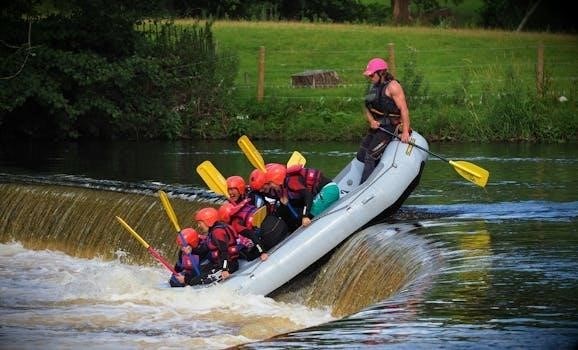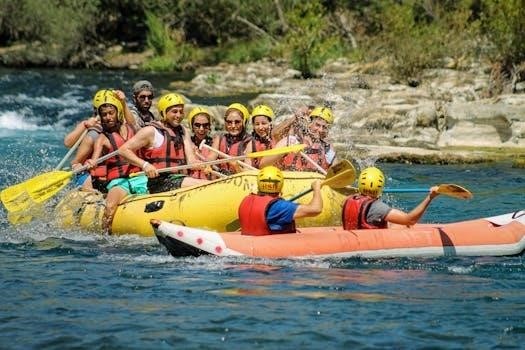How Much to Tip a Rafting Guide⁚ A Comprehensive Guide
Navigating the waters of tipping etiquette can be tricky. This guide provides a comprehensive overview of how much to tip your rafting guide. We will explore standard practices, influencing factors, and alternative tipping methods to ensure a smooth experience.
Embarking on a rafting adventure is an exciting experience, often enhanced by knowledgeable and skilled guides. Just like in other service industries, tipping is a customary way to show appreciation for their hard work and dedication. Understanding the etiquette surrounding tipping rafting guides ensures that you appropriately acknowledge their efforts in making your trip safe, enjoyable, and memorable.
This comprehensive guide will navigate the nuances of tipping in the context of white water rafting. We will explore the reasons why tipping is common practice, delve into the factors that influence the appropriate tip amount, and provide clear guidelines on standard tipping ranges. Furthermore, we will discuss the best time and methods for tipping, address situations where you might be unsatisfied with the service, and highlight the importance of guide training and preparation.
By the end of this guide, you will be well-equipped with the knowledge and understanding necessary to confidently and fairly tip your rafting guide, ensuring a positive and appreciative exchange for their services.
Why Tipping Rafting Guides is Common Practice
Tipping rafting guides is a widely accepted practice rooted in acknowledging their dedication and effort in providing a safe and enjoyable experience. Guides go beyond simply navigating the river; they ensure your well-being, share their knowledge of the environment, and often provide entertainment throughout the trip. Their expertise in river navigation, safety protocols, and local knowledge contributes significantly to the overall quality of your adventure.
Many rafting guides rely on tips to supplement their income, especially considering the seasonal nature of the job and the demanding physical requirements it entails. Tipping serves as a direct way to show appreciation for their hard work, particularly when they exceed expectations in terms of service, enthusiasm, and care. It’s a tangible way to recognize their commitment to making your rafting experience memorable.
Moreover, tipping encourages guides to maintain a high level of professionalism and dedication. Knowing that their efforts are directly rewarded incentivizes them to go the extra mile, ensuring that guests have a safe, informative, and enjoyable time on the river. It fosters a positive cycle of service and appreciation within the rafting community.
Factors Influencing Tip Amount
Determining the appropriate tip amount for a rafting guide involves considering several key factors. The quality of service is paramount; a guide’s skill, enthusiasm, and attentiveness significantly impact the overall experience. The length and difficulty of the rafting trip also play a role, as more challenging and extended trips often require greater effort and expertise from the guide.
A guide’s knowledge of the river and surrounding area is another crucial factor. Guides who share interesting facts about the local history, wildlife, and geology enhance the trip’s educational value. Furthermore, their ability to handle unexpected situations, such as equipment malfunctions or changes in river conditions, demonstrates their competence and deserves recognition.
Ultimately, the tip amount should reflect your satisfaction with the guide’s performance and the overall value of the rafting experience. While standard guidelines exist, personal considerations and the specific circumstances of the trip should inform your decision. A generous tip is a meaningful way to acknowledge exceptional service and express gratitude for a memorable adventure.

Quality of Service⁚ Skill, Enthusiasm, and Care
The quality of service provided by your rafting guide is a primary determinant of the tip amount. A skilled guide expertly navigates the river, ensuring a safe and enjoyable experience for all passengers. Their ability to handle the raft with precision, especially in challenging rapids, demonstrates their proficiency and deserves recognition. Enthusiasm is contagious, and a guide who genuinely loves their job can significantly enhance the overall atmosphere of the trip. A positive and engaging attitude creates a more memorable and enjoyable experience for everyone.
Furthermore, the level of care and attention the guide provides to the group is crucial. A caring guide is attentive to the needs of each individual, ensuring their comfort and safety throughout the trip. They proactively address concerns, offer assistance when needed, and create a supportive and inclusive environment. Guides that add to the experience with local historical information, area wildlife or geological information to their conversation in the raft deserve more.
Exceptional service, marked by skill, enthusiasm, and care, warrants a more generous tip as a token of appreciation.
Trip Length and Difficulty
The length and difficulty of the rafting trip significantly influence the appropriate tip amount. Longer trips, spanning multiple days, typically involve more extensive responsibilities for the guides, including meal preparation, camp setup, and ensuring the group’s overall well-being. These extended duties warrant a higher tip compared to shorter excursions. Similarly, the difficulty of the river also plays a crucial role. Navigating challenging rapids and potentially hazardous conditions requires a higher level of skill and expertise from the guide.
A more demanding river translates to increased effort and risk on the guide’s part, justifying a more generous gratuity. Consider the physical exertion and mental focus required to safely guide a raft through turbulent waters. Think about a week long backcountry river rafting trip that will be very supported by the guides. They will be doing all the heavy lifting, literally! It is pretty much a glamping trip. They will cook meals, set up camps, guide on the river, arrange hikes, etc. A tip should reflect that.
Therefore, both the trip’s duration and the river’s difficulty should be carefully considered when determining the appropriate tip amount.
Guide’s Knowledge of the River and Area
A rafting guide’s knowledge extends beyond simply navigating the river; it encompasses a deep understanding of the local environment, history, and potential hazards. A knowledgeable guide enriches the rafting experience by sharing insights about the river’s ecosystem, geological formations, and historical significance. This added value contributes significantly to the overall enjoyment of the trip and should be considered when determining a tip amount.
Furthermore, a guide’s familiarity with the river’s specific features, such as optimal routes, hidden dangers, and wildlife habitats, ensures a safer and more engaging journey. They can point out interesting flora and fauna, provide historical context to landmarks, and adapt the trip based on the group’s interests. A strong guide adds items such as local historical information, area wildlife or geological information to their conversation in the raft.
The ability to answer questions, provide insightful commentary, and ensure passenger safety based on their expertise merits recognition through a more generous tip. Therefore, the depth and breadth of the guide’s knowledge should factor into your tipping decision.
The Standard Tipping Range⁚ Percentages and Amounts

Determining the appropriate tip for a rafting guide often involves considering standard practices within the service industry. Generally, a tip of 10-20% of the total trip cost is considered customary, mirroring expectations in restaurants or other service sectors. However, the precise percentage can fluctuate based on several factors, including the quality of service received and the length/difficulty of the trip.
Alternatively, some individuals prefer to tip a fixed amount per person, typically ranging from $5 to $20 per rafter. This approach is particularly suitable for shorter rafting excursions or when the overall trip cost is relatively low. For groups, $50-$100 is recommended per raft guide.
It’s important to remember that these figures serve as guidelines. The ultimate decision regarding the tip amount rests with the individual, reflecting their appreciation for the guide’s efforts and the overall satisfaction with the experience. Consider the guide’s dedication, knowledge, and enthusiasm when determining the appropriate tip.
General Rule⁚ 10-20% of Trip Cost
As a general guideline for tipping rafting guides, a common practice is to allocate 10-20% of the total cost of your rafting trip. This percentage aligns with standard tipping norms in other service industries, such as restaurants or hair salons. This range provides a benchmark for expressing appreciation for the guide’s efforts and expertise during the excursion.
For instance, if your rafting trip cost $500, a tip within the 10-20% range would amount to $50-$100. This amount serves as a tangible recognition of the guide’s role in ensuring a safe, enjoyable, and memorable experience on the river. Remember that this is just a suggested range, and the final amount you choose to tip should reflect your personal satisfaction with the service provided.
Consider the guide’s attentiveness, knowledge of the river, and overall enthusiasm when deciding on the specific percentage within this range. Ultimately, the goal is to express your gratitude in a meaningful and appropriate manner.
Alternative⁚ $5-20 Per Person
While the 10-20% rule is a common guideline, an alternative approach involves tipping a fixed amount per person. A range of $5-$20 per person is a reasonable alternative, especially for shorter trips or when the total trip cost is relatively low. This method can be simpler to calculate, particularly for larger groups.
For example, if you are part of a group of four, tipping $10 per person would result in a total tip of $40 for the guide. This approach ensures that the guide receives a fair gratuity, regardless of the overall trip expenditure. The specific amount within this range can be adjusted based on the guide’s performance and your overall satisfaction.
Factors to consider include the length and difficulty of the trip, as well as the guide’s level of engagement and expertise. If the guide went above and beyond to ensure a memorable experience, a higher per-person tip would be appropriate. Conversely, for shorter or less demanding trips, a smaller amount may be sufficient.
Considerations for Multi-Day Trips

Tipping on multi-day rafting trips requires careful consideration, as the guides provide extensive service over an extended period. The standard 10-20% guideline of the total trip cost is generally applicable, but it’s crucial to factor in the increased level of commitment and effort from the guides.

For multi-day excursions, guides often handle tasks beyond just navigating the river. They may be responsible for cooking meals, setting up campsites, arranging hikes, and providing entertainment. This expanded role warrants a more generous gratuity. A good starting point is 15%, but exceeding 20% is appropriate for exceptional service.
Another option is to allocate a specific amount per day per person, such as $20-$50, depending on the trip’s intensity and the guide’s performance. It is also acceptable to tip guides individually or give the tip to the trip leader, who will divide it among the team. Consider the length, difficulty, and guides’ dedication.
When and How to Tip
Timing and method are important considerations when tipping your rafting guide. The best time to present the tip is generally at the end of the trip, after you’ve had a chance to fully appreciate their service. This allows you to reflect on the overall experience and determine an appropriate amount based on their performance.
Cash is the most preferred and direct method of tipping, as it ensures the guide receives the full amount immediately. However, if you don’t have cash on hand, many rafting companies offer alternative options. Some may allow you to add the tip to your credit card payment, while others might accept electronic transfers via platforms like Venmo.
If there are multiple guides, you can either tip each guide individually or give the entire tip to the trip leader to distribute among the team. Always express your gratitude and appreciation when giving the tip.
Best Time to Tip⁚ End of the Trip
The most opportune moment to offer a gratuity to your rafting guide is at the conclusion of the rafting excursion. This timing allows you to fully assess the quality of service provided throughout the entire trip. By waiting until the end, you can accurately gauge the guide’s skill, enthusiasm, knowledge, and attentiveness to your group’s needs.
Furthermore, tipping at the end provides a natural opportunity to express your appreciation verbally, offering specific feedback on what aspects of the guide’s service you particularly enjoyed. This personal touch can make the gesture of tipping even more meaningful.
Consider waiting until you are safely back at the rafting base or disembarkation point. This ensures a convenient and appropriate setting for the transaction, allowing you to thank your guide directly for their efforts.
Acceptable Methods⁚ Cash, Credit Card, or Venmo
When it comes to showing your appreciation through a tip, several convenient methods are generally accepted. The most traditional and often preferred method is cash. This allows for immediate and direct acknowledgment of the guide’s service.
Many rafting companies now offer the option to add a gratuity to your bill when paying with a credit card. Check with the adventure coordinators beforehand to confirm this option. This is a convenient way to tip if you don’t have cash on hand.
In today’s digital age, some guides may also accept tips through mobile payment apps like Venmo. Don’t hesitate to ask if this is an option, especially if you prefer cashless transactions. Always confirm the guide’s Venmo username before sending any money.
Giving Tips to Trip Leaders vs. Individual Guides
On multi-day rafting trips or those with larger groups, you might encounter both a trip leader and individual guides. Determining who to tip can sometimes be confusing. The common practice is that on overnight trips, you can tip guides individually, or give a tip to the trip leader who will divvy it up among all the other guides.
If you felt a particular connection with a specific guide, you might choose to tip them directly. This allows you to acknowledge their individual contributions to your experience. On the other hand, tipping the trip leader is a good option if you want to ensure everyone on the team is recognized. The trip leader is usually responsible for distributing the tips fairly among the crew.
What if You’re Unsatisfied with the Service?
While tipping is customary, it’s essential to consider what to do if you’re genuinely dissatisfied with the service provided. Start by calmly addressing your concerns with the trip leader or the rafting company. Providing constructive feedback allows them to improve future experiences for others. Explain the specific issues you encountered, whether it was a lack of knowledge, poor safety practices, or a negative attitude.
Withholding a tip entirely can be a way to express your dissatisfaction. However, it’s generally recommended to communicate your concerns first. If the issues are not resolved, reducing the tip amount can be a reasonable compromise. Remember, a tip should reflect the quality of service you received. Not tipping without feedback can get a little weird for all parties.
The Importance of Guide Training and Preparation
Rafting guides undergo rigorous training programs to ensure your safety and enjoyment on the river. These programs cover essential skills like first aid, CPR, equipment maintenance, and river navigation. Guides learn to handle various situations, from calm waters to challenging rapids. They also receive training in customer service, communication, and local knowledge.
A well-trained guide can provide valuable insights into the river’s ecosystem, history, and geology. They can also offer tips on wildlife spotting and enhance your overall experience. Investing in guide training is crucial for rafting companies to maintain high safety standards and deliver exceptional service. Consider this extensive preparation when determining an appropriate tip, as their expertise contributes significantly to a memorable and secure adventure. The guide’s dedication to training directly impacts your experience.

